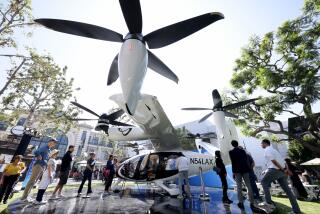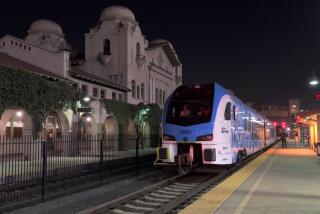JetSuite strikes a deal for hybrid electric planes with start-up Zunum Aero
Irvine charter jet operator JetSuite will add hybrid electric planes to its fleet starting in 2022. It is the first substantial commercial order of an aircraft technology that could cut fuel costs and emissions, and make flights quieter.
The planes, which will seat up to 12 passengers, are being developed by Bothell, Wash., electric aircraft start-up Zunum Aero. The company, which has 70 full- and part-time employees, has received backing from Boeing Co.’s venture capital arm, as well as JetBlue Technology Ventures.
JetSuite expects to receive about one plane a month for the first year or two, with deliveries accelerating from there, said Chief Executive Alex Wilcox. The company said it would add as many as 100 Zunum aircraft to its fleet.
Over the years, a few electricity-powered planes have been developed as test vehicles, including a two-seater Airbus aircraft that flew over the English Channel in 2015 and a solar-powered plane that completed an around-the-world journey a year later.
But aviation experts have said battery technology is the major hurdle to developing a commercial electric plane, making a hybrid aircraft a more viable option.
In Zunum‚Äôs plane, battery packs are located in each wing and will be relied upon first to power the aircraft. The plane‚Äôs rear fuselage can be used to store either a third battery pack ‚ÄĒ to make the plane fully electric ‚ÄĒ or in the case of JetSuite, a range extender consisting of a traditional gas turbine coupled with a generator that creates electricity to power the plane‚Äôs electric motors, said Ashish Kumar, chief executive of Zunum.
The plane’s computer system calculates ahead of time when the turbogenerator will need to turn on during flight, he said. The hybrid plane’s range is 700 miles and it has a maximum cruise speed of 340 mph.
‚ÄúThis is very, very carefully optimized so as batteries improve, more and more of the flight becomes electric,‚ÄĚ Kumar said.
Though technology has improved, batteries‚Äô specific weight ‚ÄĒ or the amount of energy they can store for a given amount of weight ‚ÄĒ has not advanced enough to achieve significant range. That means an all-electric plane would need to carry a large number of batteries to get the same energy as jet fuel, said Alejandra Uranga, Gabilan assistant professor of aerospace and mechanical engineering at USC.
On planes, weight is a crucial factor. ‚ÄúIt‚Äôs very expensive to carry weight on an aircraft,‚ÄĚ she said.
If battery technology continues to progress at its current rate, commercial aviation probably would be ‚Äúmuch more prone to use of hybrid than fully electric,‚ÄĚ said Pat Anderson, director of Embry-Riddle Aeronautical University‚Äôs flight research center and a professor of aerospace engineering.
‚ÄúThe hybrid does afford you the capability of having range and endurance that is between electric and gas, yet it has less direct operating costs and fuel emissions, possibly, than the gas counterpart,‚ÄĚ he said.
However, hybrids could also run into a slight problem with weight, as they must incorporate both a fully electric system and a conventional engine, he said.
Wilcox of JetSuite said Zunum‚Äôs flexible design of the plane, which can later be converted into a fully electric aircraft, was a more ‚Äúrealistic approach.‚ÄĚ
The hybrid planes would be used first for JetSuite’s private charter jet service, though the company plans to later use the aircraft for its JetSuiteX service, a public charter jet option that flies between several destinations in California and Nevada.
The hybrid planes would first be used as a supplement to the company‚Äôs existing fleet, though Wilcox said the company would be ‚Äúmassively economically incentivized to change out the entire fleet to all hybrid planes.‚ÄĚ
The company expects it will save 80% in fuel costs on the Zunum planes.
‚ÄúWe spend way more on fuel than we do on airplanes today,‚ÄĚ Wilcox said. ‚ÄúThe savings on gas will more than pay for the difference.‚ÄĚ
Wilcox has said JetSuite probably will look at incorporating the hybrid planes into routes that are 200 to 500 miles long, such as Los Angeles to Las Vegas, or Santa Monica to Mammoth Lakes. The plane’s ability to take off on a runway of just 2,200 feet could also open up new markets, he said.
He mused that one option could be short, intra-state flights ‚ÄĒ say, from Ontario to San Diego ‚ÄĒ that could compete with the likes of Uber, which has unveiled plans for urban flying taxi services using vertical takeoff and landing craft.
Zunum plans to conduct flight tests of its electric propulsion system next year. The company is developing its own electric motor that will be added to an existing aircraft for test purposes, before later incorporating the turbogenerator.
Twitter: @smasunaga
More to Read
Inside the business of entertainment
The Wide Shot brings you news, analysis and insights on everything from streaming wars to production ‚ÄĒ and what it all means for the future.
You may occasionally receive promotional content from the Los Angeles Times.











